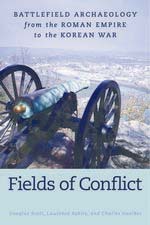
Fields of Conflict
Douglas Scott, Lawrence Babits and Charles Haecker
450 pages including index
Fields of Conflicts is a collection of essays on battlefield archaeology, based on papers presented on a conference of the same title as the book, held in 2004. Battlefield archaeology as a separate discipline is a relatively recent development, even if military history is of course of quite ancient vintage. Astounding as it may seems, battlefield archaeology only got started in the early eighties, with a groundbreaking research paper on the Little Bighorn battlefield. Though it seems obvious in retrospect to apply archaeological techniques in researching battles and battlefields, battlefields are such ephemeral sites, battles rarely lasting more than a day, while archaeology traditionally focused on sites that had been inhabitated for centuries, that it's no wonder it took so long for somebody to do so. That somebody was Douglas Scott, also one of the editors of this volume and you realise the impact of his research by seeing how often in the essays collected here it is refered to.
In fact, Douglas Scott is so influential that I've seen him on the History Channel showcasing his Little Big Horn research a few years ago, which was the first time I heard of battlefield archaeology. It was fascinating to see how it was possible to almost track the movement of single soldiers on the battlefield by hunting for the detritus they left behind in the course of the battle. Fields of Conflicts shows how much can be known of even obscure battles this way, through creative use of archaeological techniques and especially metal dectoring, but also how much still remains unknownable as well. It's a fascinating read even for armchair historians like myself, a glimpse in how the real professionals handle these problems.
The way in which Fields of Conflict is structured helps make it easier for lay people like me to get into the subject. It's roughly divided into two, with the first series of essays serving as a general introduction to the subject of battle archaeology and its challenges and the second series a showcase of how the methods developed are applied to specific battlefields. Both series are assembled in chronological order, going from ancient to modern battlefields, from the Battle of Varus to a small battle during the Korean War, with the schwerpunkt lying in the nineteenth century.
Geographically, most of the battlefields featured are either North American or European, with only two exceptions: the aforementioned Korean War battlefield, as well as an essay on the archaeology of the War of the Triple Alliance. The American Civil War is very well represented, with no less than six essays devoted to it. This selection is not that surprising, considering the origins of battlefield archaeology and the seemingly continued Anglosaxon dominance of it since. It would've been nice to see some essays focusing on non-western battles as well, or on more ancient and more modern battles, but you can't blame people for focusing on battles of local interest.
Despite these quibbles and despite the unavoidable repetition that a book of essays on the same subject brings with it, there isn't an uninteresting essay in the book. Though there is some overlap, the details of each battle are different enough to not bore you. Often in fact I was left wanting to know more about the battle described, especially about the smaller, more obscure ones described in the second part of the book.
The same went for the techniques described in the first part, the most technical part of the book. It starts with a discussion of how a battlefield can be recognised, through various technological means including metal detector sweeps and remote sensoring, with the second article looking for shared characteristics historic battlefields shared, before moving on to more specialised subjects. How to find artillery battery positions, what can be learned from bullets and musket balls found at a battlefield and their distribution on it, how to determine what a given commander could see of a battle, how to identify firearms used, all are discussed. It's worth reading Fields of Conflict for just this part alone.
The second part is less focused on technique and more on its application to various battlefields, so might be a little less interesting in that regard. However, the practical problems and solutions in using these techniques, for example how to get data from a battlefield already largely depleted by the removal of artifacts by collectors with metal detactors, is still fascinating. And, as said before, reading up on obscure battles is a pleasure in itself.
Fields of Conflict than is an excellent book for the military history enthusiast like myself and is highly recommended.